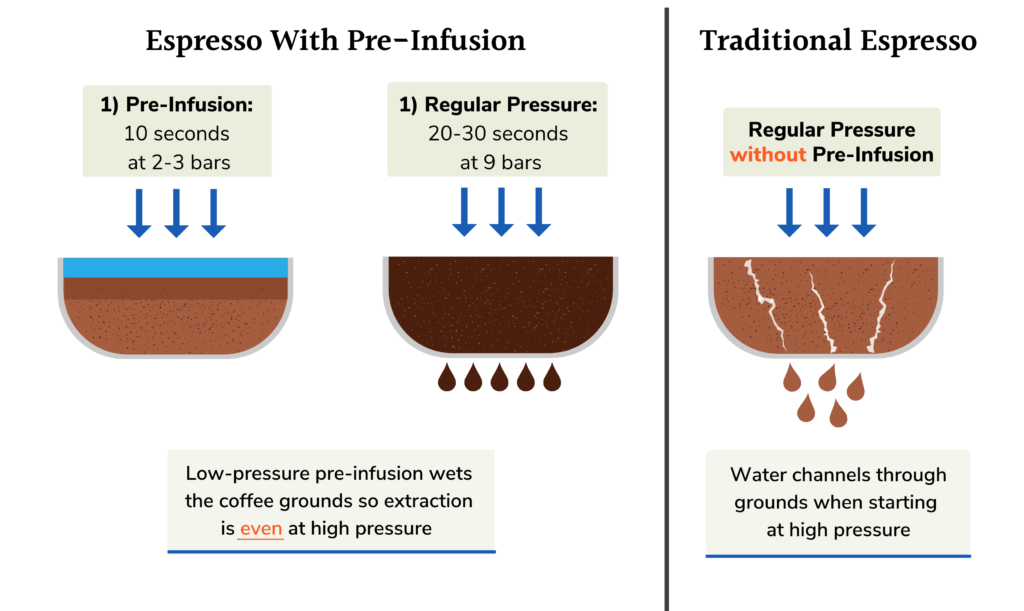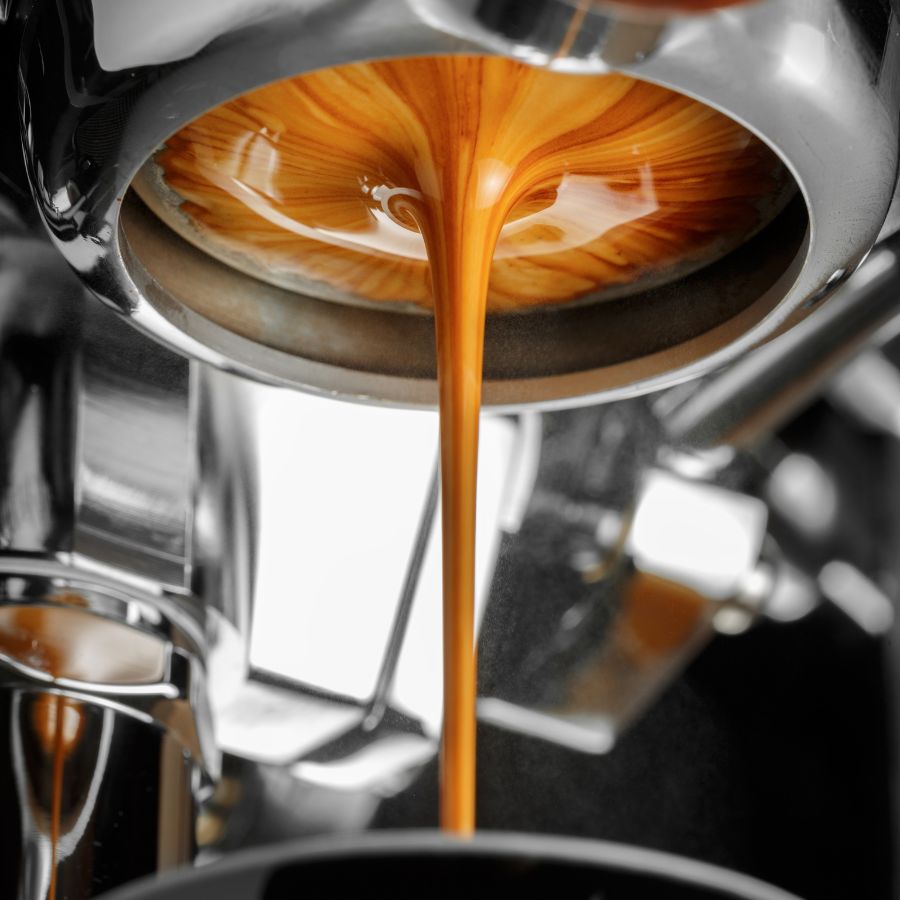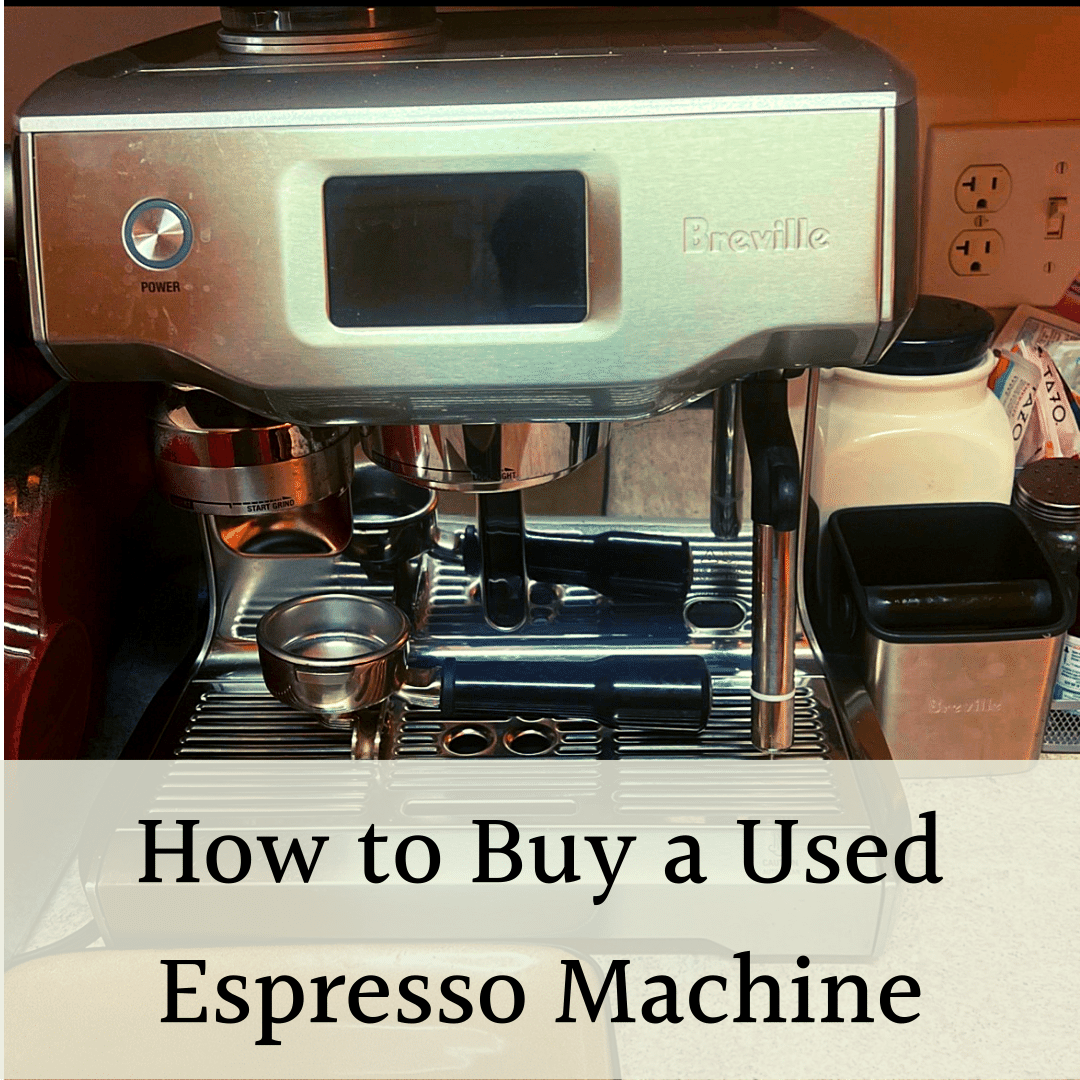For espresso aficionados with their own machines, mastering the art of the perfect brew is a continuous journey. One game-changing technique to elevate your espresso is the pre-infusion process.
Pre-infusion involves introducing water to the coffee puck at a gentler pressure initially, before ramping up to full extraction. This preliminary interaction between the water and coffee minimizes channeling, which leads to a more consistent and flavorful extraction.
In this guide, I’ll delve into the nuances of pre-infusion: its essence, its benefits, and the optimal duration. Once you have this knowledge, you’ll be able to craft a rich and aromatic espresso every time.
What Is Pre-Infusion?
Pre-infusion is the process of gently soaking coffee grounds before applying the full brewing pressure. The water saturates the coffee puck evenly at lower pressure (usually around three bars).
Pre-infusion ensures the entire coffee bed is even, so water flows more consistently at the full nine bars of pressure. Overall, you get a tastier espresso shot and less room for error with espresso pre-infusion.

Essentially, pre-infusion for espresso is like a coffee bloom when making pour-over coffee. You add a small amount of water, so the puck is wet. Espresso machines use two bars of pressure to pre-infuse coffee.
When you initially wet the grounds, carbon dioxide is released from the coffee grounds and replaced with water during the coffee blooming. This “bloom” process during pre-infusion makes the coffee grounds rise and grow and release the oils. Carbon dioxide repels water, and therefore the bloom part of pre-infusion results in a more flavorful cup of espresso.
There’s also a second benefit that’s more important. Pre-infusion stage reduces the chance of channeling, which is when water finds a path through the bed of ground coffee beans. You’ll notice visible cracks or “channels” in the coffee puck. The water flows through this channel and avoids other grounds. The channel through which the water flows ends up over-extracted, and the rest of the puck is under-extracted. The result is a sour and bitter espresso.
Espresso pre-infusion is beneficial for both espresso newbies and professionals. If you’re just entering the world of espresso, pre-infusion can even out the inconsistencies in the distribution of coffee grounds in your portafilter.
For example, if you don’t distribute the coffee grounds evenly in the puck, you’ll have cracks and air pockets. Or, you’ve tamped unevenly, so there’s a spot in the puck that’s less dense than the rest. If you were to brew at full nine bars of pressure, the water would create channeling when it hits the puck. But, when you pre-infuse the coffee puck with hot water, there’s a much lower chance of channeling.
How Does Pre-Infusion Work?
Different machines create low pressure in different ways. Many machines build it into the pump design to start at lower pressure. Others use a restrictor to reduce the flow for a pre-infusion.
You’ll notice newer automatic machines build in a pre-infusion function, like the newer Breville line-up. They automatically include 2-5 seconds of low pressure before the pumps increase to full pressure.
If you have a classic E61 group head or plumbed-in espresso machine, the line creates water pressure. Lift the brew lever partway to open the pathway between the group head and the water inlet to create low pressure (you don’t want to turn on the pump). As soon as the pre-infusion is done, you should turn on the pump by lifting the lever all the way on lever-operated espresso machines.
If your espresso machine doesn’t have pre-infusion, you can go around it by turning the pump on and off. This is a crude method, and you’ll infuse the puck with water at full pressure, which can break up the puck.
Grinding tip: Pre-infusion lets the water run faster through the coffee grounds because it expands and evens the puck. This means you need to grind finer to compensate for this. That’s better, too, because you can get more extraction!
How Long Does Pre-Infusing Espresso Take?
My advice is to go for a 10-second pre-infusion. Most espresso machines are programmed to have a pre-infusion time of only a few seconds, but a longer pre-infusion is better. You’ll have a more consistent extraction, giving you an espresso shot with bright acidity, a heavier body, and a creamier texture.

To be fair, there’s no fixed answer on how long pre-infusing espresso should take. Most recommend two to eight seconds, while others go up to 30 seconds! This depends on your espresso machine, coffee beans, roast level, whether it’s a blend or single origin, how fine the grounds are, and more. In other words, you should experiment with pre-infusion time to find what works best for you.
Keep in mind that pre-infusion will change the taste of your coffee. In general, longer pre-infusion times will lead to more extracted and potentially bitter coffee.
Play around with the coffee and water volume, and try a 30-second pre-infusion time as well. As you experiment, the best advice is to do what tastes best. Also, always start the extraction process as soon as pre-infusion is done.
What Is Pressure Profiling?
Pressure profiling is the process of continually adjusting the pressure to create an even water flow through the coffee grounds in the puck. You gradually increase the water pressure from pre-infusion throughout the brewing process. You should have peak pressure at the end of pulling the espresso shot.

In other words, pressure profiling is a more advanced version of pre-infusion, with a more gradual pressure increase instead of a two-step function. Similar to pre-infusion, pressure profiling improves extraction.
You can also do pressure profiling by starting at high pressure and ending at low. Both versions will give the espresso shot different flavors.
Everything I said about channeling above goes for pressure profiling. You use pressure profiling to have an even rate of water flow and eliminate the chance of channeling. Slowly increasing the pressure during the brewing process balances the extraction. You’ll see an improvement in the texture and flavor of your espresso by setting new pressure parameters.
Manual espresso machines allow basic pressure profiling. You pull the lever down to let water into the group head at low pressure. The spring forces the lever back to its original position, resulting in rising and declining pressure.
Same as with pre-infusion, no one answer fits all. You need to experiment to find what works best for you. This includes dosage, pre-infusion, coffee grounds grind and consistency, roast, temperature, and more.
Overall, pressure profiling isn’t a magic cure for bad coffee. But it lets you change the volume of flavor components in your espresso and gives you a better chance of discovering hidden flavors. It usually produces a rounder espresso with more noticeable bright and sweet notes.
Pre-Infusion: Final Thoughts
I’m firmly in favor of pre-infusion. It helps eliminate or mask errors with puck prep during the brewing process. You don’t have to stress over the coffee grind, distribution, or tamping. Pre-infusion is not a magic solution, but it can help you consistently have a better espresso.
For a better chance of creating a flavorful espresso, check out our guides on grind size and a complete guide on improving espresso.




